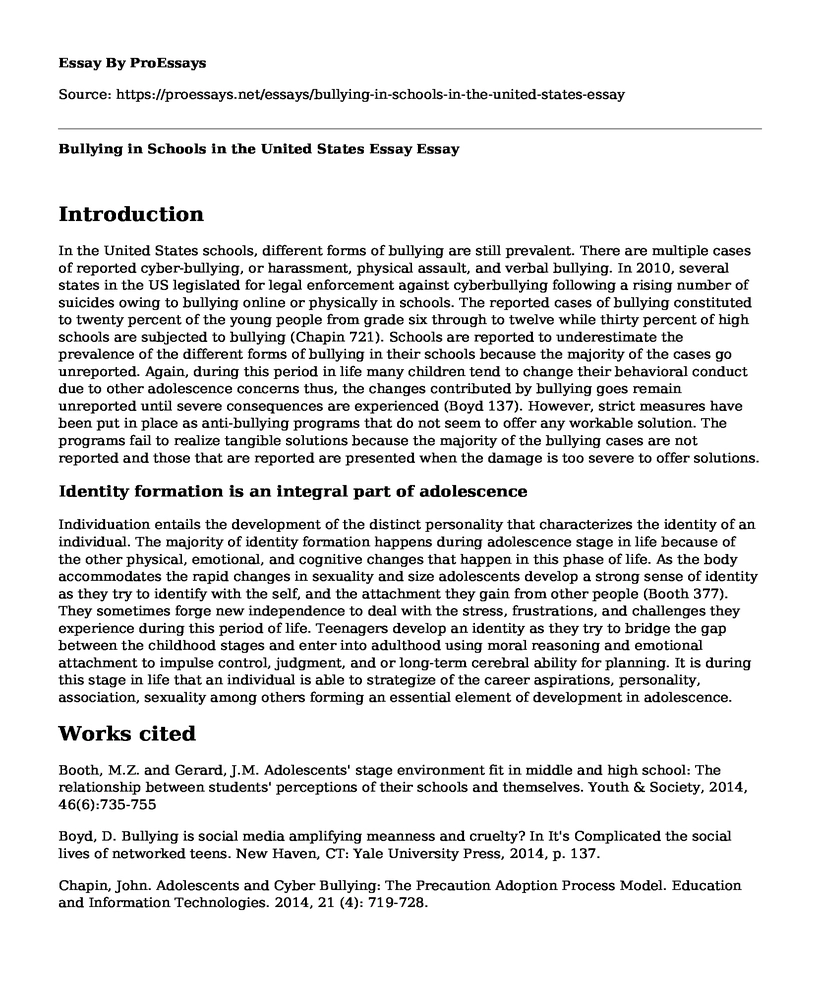Introduction
In the United States schools, different forms of bullying are still prevalent. There are multiple cases of reported cyber-bullying, or harassment, physical assault, and verbal bullying. In 2010, several states in the US legislated for legal enforcement against cyberbullying following a rising number of suicides owing to bullying online or physically in schools. The reported cases of bullying constituted to twenty percent of the young people from grade six through to twelve while thirty percent of high schools are subjected to bullying (Chapin 721). Schools are reported to underestimate the prevalence of the different forms of bullying in their schools because the majority of the cases go unreported. Again, during this period in life many children tend to change their behavioral conduct due to other adolescence concerns thus, the changes contributed by bullying goes remain unreported until severe consequences are experienced (Boyd 137). However, strict measures have been put in place as anti-bullying programs that do not seem to offer any workable solution. The programs fail to realize tangible solutions because the majority of the bullying cases are not reported and those that are reported are presented when the damage is too severe to offer solutions.
Identity formation is an integral part of adolescence
Individuation entails the development of the distinct personality that characterizes the identity of an individual. The majority of identity formation happens during adolescence stage in life because of the other physical, emotional, and cognitive changes that happen in this phase of life. As the body accommodates the rapid changes in sexuality and size adolescents develop a strong sense of identity as they try to identify with the self, and the attachment they gain from other people (Booth 377). They sometimes forge new independence to deal with the stress, frustrations, and challenges they experience during this period of life. Teenagers develop an identity as they try to bridge the gap between the childhood stages and enter into adulthood using moral reasoning and emotional attachment to impulse control, judgment, and or long-term cerebral ability for planning. It is during this stage in life that an individual is able to strategize of the career aspirations, personality, association, sexuality among others forming an essential element of development in adolescence.
Works cited
Booth, M.Z. and Gerard, J.M. Adolescents' stage environment fit in middle and high school: The relationship between students' perceptions of their schools and themselves. Youth & Society, 2014, 46(6):735-755
Boyd, D. Bullying is social media amplifying meanness and cruelty? In It's Complicated the social lives of networked teens. New Haven, CT: Yale University Press, 2014, p. 137.
Chapin, John. Adolescents and Cyber Bullying: The Precaution Adoption Process Model. Education and Information Technologies. 2014, 21 (4): 719-728.
Cite this page
Bullying in Schools in the United States Essay. (2022, Jul 06). Retrieved from https://proessays.net/essays/bullying-in-schools-in-the-united-states-essay
If you are the original author of this essay and no longer wish to have it published on the ProEssays website, please click below to request its removal:
- Rotary Club Essay for Scholarship
- Background LDP Case Study
- The Impact of ADHD on Children's Academic Performance Essay
- Population Boom: The Impact on Housing and Homelessness - Essay Sample
- Paper Sample on Consumer Protection in E-Commerce: Return & Refund Policies
- Paper Example on US Drone Strikes: Targeting Terrorists Beyond War Zones
- Navigating the Uncertainties of Global Trade Tariffs: Challenges, Risks, and Strategies - Free Report







